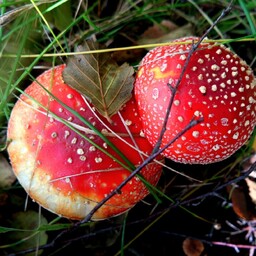Mürgistusteabekeskus on suvel saanud ligi 60 kõnet. Enamik kõnesid on olnud laste leitud ussilaka marjade ja seenede pärast.
Kelli Suvi ütleb, et ussilaka marjad on küll mürgised, aga nad maitsevad halvasti. Seepärast lapsed ei söö neid palju korraga. Kuni viie marja söömine ei põhjusta suuri terviseprobleeme.
See suvi on olnud vihmane, seepärast on seened varakult välja tulnud. Seeneliike ei pea otsima metsast,
neid leidub ka kodumurult
. Paljud kõned on olnud väikelaste pruunide seenede söömise pärast.
neid leidub ka kodumurult
Tõlge fraasile: neid leidub ka kodumurult
EN
they can also be found in the backyard
Kui laps on söönud seent, tuleb tal
suu puhastada
ja tema enesetunnet jälgida. Need seened pole mürgised, aga nad võivad põhjustada lapsel oksendamist või peavalu. Kui
sümptomid ilmnevad
, tuleb
helistada mürgistusteabekeskusse
.
suu puhastada
Tõlge fraasile: suu puhastada
EN
clean the mouth
sümptomid ilmnevad
Tõlge fraasile: sümptomid ilmnevad
EN
symptoms appear
helistada mürgistusteabekeskusse
Tõlge fraasile: helistada mürgistusteabekeskusse
EN
call the Poison Information Centre
Rästikuhammustusi on tänavu vähem kui eelmisel aastal. Sel aastal on neid olnud 12, eelmisel aastal 35.
Enamik mürgistusjuhtumeid on
suviti väikelaste seas
. Tihti tekivad need koduste kemikaalide või ravimite tõttu. Ravimid võivad olla segi,
kemikaalid kergesti käeulatuses
või laps sööb maha visatud nikotiinipadja.
suviti väikelaste seas
Tõlge fraasile: suviti väikelaste seas
EN
among young children in summer
kemikaalid kergesti käeulatuses
Tõlge fraasile: kemikaalid kergesti käeulatuses
EN
chemicals easily within reach
Kui
kahtlustad mürgistust
,
ära oota sümptomite ilmumist
, vaid helista kohe numbril 16662. Nõu saad eesti, inglise ja vene keeles.
kahtlustad mürgistust
Tõlge fraasile: kahtlustad mürgistust
EN
suspect poisoning
ära oota sümptomite ilmumist
Tõlge fraasile: ära oota sümptomite ilmumist
EN
don't wait for symptoms to appear
The Poison Information Center has received nearly 60 calls this summer. Most calls have been about children finding wolf's bane berries and mushrooms.
Kelli Suvi says that wolf's bane berries are indeed poisonous, but they taste bad. Therefore, children do not eat many at once. Eating up to five berries does not cause major health problems.
This summer has been rainy, which is why mushrooms have appeared early. You don't have to look for mushroom species in the forest; they can also be found in the yard. Many calls have been about young children eating brown mushrooms.
If a child has eaten a mushroom, their mouth should be cleaned, and their condition should be monitored. These mushrooms are not poisonous, but they may cause vomiting or headaches in children. If symptoms appear, call the Poison Information Center.
There have been fewer snake bites this year than last. This year, there have been 12, compared to 35 last year.
Most poisoning cases in summer involve young children. Often, these occur due to household chemicals or medications. Medications may be mixed up, chemicals may be easily accessible, or a child may eat a discarded nicotine pouch.
If you suspect poisoning, do not wait for symptoms to appear; call 16662 immediately. Advice is available in Estonian, English, and Russian.

